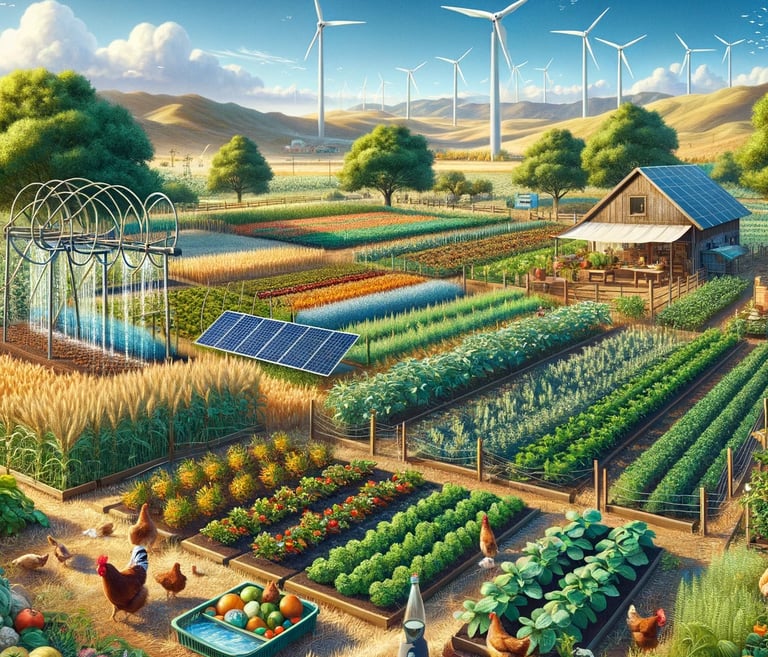Sustainable Agriculture: The Path to a Greener Future
zivaiclimate
2/11/20243 min read


In the face of climate change, sustainable agriculture emerges not just as a method of food production but as a beacon of hope for our planet's future. This approach balances the need for food security with the necessity to protect the environment, ensuring that we can feed today's global population while safeguarding resources for generations to come. In this comprehensive guide, we delve into the techniques farmers can employ to embrace sustainable agriculture, illustrating a path towards a more resilient and eco-friendly farming paradigm.
Understanding Sustainable Agriculture
Sustainable agriculture is the practice of farming using principles designed to protect the environment, expand the Earth’s natural resource base, and maintain and improve soil fertility. Based on an understanding of ecosystem services, it integrates three main goals: environmental health, economic profitability, and social and economic equity. This approach to farming takes many forms, depending on factors such as location, climate, and the types of crops grown. But at its core, it shares common techniques aimed at reducing environmental impact and preserving the earth for future generations.
Key Techniques for Sustainable Agriculture
1. Crop Rotation: One of the oldest and most powerful techniques in sustainable farming, crop rotation involves changing the type of crop grown in a particular area with each season. This practice prevents soil depletion, reduces soil erosion, and helps control pests and diseases, leading to healthier crops and a reduction in the need for chemical fertilizers and pesticides.
2. Cover Cropping: Growing cover crops like clover or hairy vetch during off-season times is crucial for soil health. These plants protect the soil from erosion, improve soil fertility by fixing nitrogen from the air, and provide organic matter. Cover crops also suppress weeds, reducing the need for herbicides.
3. Soil Conservation: Techniques such as no-till farming, conservation tillage, and contour farming minimize soil disturbance, preserve soil structure, and prevent water and wind erosion. These practices are vital in maintaining healthy soil, which is the foundation of sustainable agriculture.
4. Integrated Pest Management (IPM): IPM is a holistic approach to pest control that combines different strategies and practices to minimize the use of pesticides. By using biological control agents, crop rotation, and resistant varieties, farmers can effectively manage pests in an eco-friendly way.
5. Agroforestry and Permaculture: Integrating trees and shrubs into agricultural landscapes (agroforestry) and designing farming systems that mimic natural ecosystems (permaculture) can enhance biodiversity, improve soil health, and increase crop yields. These practices offer a resilient agricultural system that is more resistant to climate change, pests, and diseases.
6. Efficient Water Use: Implementing efficient irrigation practices such as drip irrigation and sprinkler systems can significantly reduce water usage in agriculture. Collecting rainwater, using water-conserving crops, and optimizing irrigation schedules also contribute to water sustainability.
7. Organic Farming: By avoiding or significantly reducing the use of synthetic pesticides and fertilizers, organic farming supports biodiversity, reduces contamination of water bodies, and builds healthy, fertile soil. Organic certification also opens market opportunities for farmers, potentially leading to higher profitability.
The Economic and Social Impact
Sustainable agriculture not only benefits the environment but also offers economic advantages to farmers. By reducing inputs such as chemical fertilizers and pesticides, farmers can lower their costs of production. Sustainable practices can also yield products with higher market value, particularly in markets sensitive to environmental and health issues.
Moreover, sustainable farming practices contribute to social equity by ensuring that small-scale farmers have the resources and knowledge they need to improve their livelihoods and contribute to food security in their communities. It supports the well-being of all farmers, rural communities, and consumers by providing them with healthy, nutritious food.
Embracing the Future
The transition to sustainable agriculture is not merely an option but a necessity in our fight against climate change. By adopting sustainable farming techniques, farmers play a pivotal role in creating a resilient food system that can withstand the challenges posed by a changing climate. It's a journey that requires the support of policies, incentives, and education to empower farmers and communities to make the shift.
As consumers, we can also drive change by choosing products that are sustainably sourced, supporting local farmers, and being mindful of our food consumption patterns. Together, through sustainable agriculture, we can nurture the planet, feed its inhabitants, and sow the seeds for a healthier future.
In conclusion, sustainable agriculture stands as a testament to our ability to harmonize human needs with environmental stewardship. By embracing these practices, we commit to a more sustainable, equitable, and prosperous world. Let us all support and advocate for sustainable agriculture as the path forward, ensuring a greener, more fruitful future for our planet.
References
Robinson, J. (2021). The Future of Farming: Sustainable Practices for a Healthy Planet. Green Earth Publishing.
Miller, A., & Davis, B. (2019). Sustainable Agriculture: Principles and Practices. Earthwise Publications.
Smith, E.R., & Johnson, L.K. (2022). "Effects of Crop Rotation on Soil Health and Productivity." Journal of Sustainable Agriculture, 34(2), 155-172.
Thompson, W., & Gomez, A. (2020). "Water Conservation Techniques in Agriculture: A Review." Environmental Science & Technology Review, 45(4), 289-305.
image credit DALL.E
